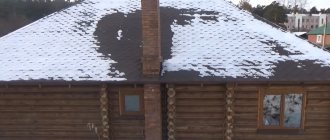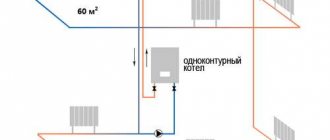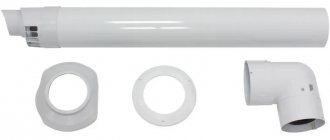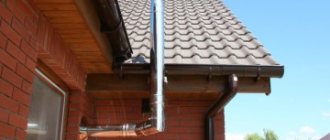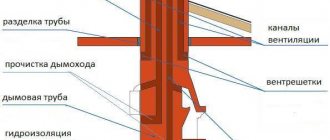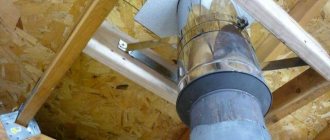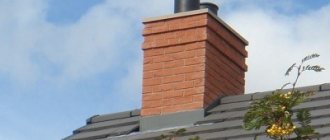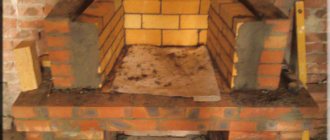Every person who decides to build a bathhouse faces a difficult moment in choosing the material for the construction of the chimney. I want to make a smoke exhaust system quickly and inexpensively.
Ceramics are good, but expensive, brick is also great, but difficult. You can use metal, but you will need a welding machine to make the chimney.
Sandwich pipe is also not the cheapest material, and not all stores sell it, especially if the developer lives in a village. We have heard about stainless steel, and assembling a chimney from it is a simple matter, but for some reason we never get around to it.
And here some “specialists” come to the rescue, who unanimously suggest using an asbestos pipe as a chimney.
There are a lot of arguments in favor of its use. The most important one: “Look, I’ve had an asbestos chimney for 50 years and will stand for the same amount of time, and nothing has happened to it.”
The second argument is already on its way: “The chimney is installed simply, quickly, and tomorrow you will be testing the steam room,” and the deadlines are running out.
And when you first thought about it, someone will definitely say: “Yes, I have a lot of them, let’s go, I’ll give it to you for free.” After this, 90% of developers agree with the proposal, since the last argument almost always wins.
Let's figure out whether an asbestos chimney is so good.
Methods for insulating asbestos pipes
Asbestos pipes are a simple, affordable and very effective solution for many communications. They have proven themselves excellent as chimneys. They are not demanding on the quality of the connection, can come into contact with different materials, and are capable of serving for a sufficient number of years, fulfilling their functions. However, many users have a question: do they need to be insulated? And if so, what materials should be used for this?
We will answer all questions further, covering the topic of insulation of asbestos pipes.
Purpose of asbestos cement pipes
The widespread use of asbestos-cement pipes began during land reclamation. Their main advantage was their low price.
Asbestos pipes
New times have come, land reclamation, as well as agriculture, have sunk into oblivion. Asbestos cement pipes remain. During the period of mass construction of individual housing, many developers began to use asbestos-cement pipes for chimneys, which were not originally intended for this purpose.
Why is this necessary?
Indeed, why insulate an asbestos pipe that is used, for example, as a chimney? When wood or coal burns, steam appears in the chimney, and a certain part of it settles on the walls of this structure. Steam condensation occurs as a result of the temperature difference between the atmosphere and the pipe.
When the heating is turned on, it is cold outside, which means cool air surrounds the chimney. The material itself is heated as a result of the operation of the boiler or stove. As a result of water condensation on the surface of the asbestos pipe, its destruction occurs. In addition, when wood or coal is burned, chemicals are formed that have a negative effect on the material.
When the boiler or stove is not heated, the pipe cools, condensate is absorbed by the material, and gradual destruction occurs. Thanks to insulation, you can slow down negative processes, and therefore extend the service life of the chimney.
The same thing happens with other options for using asbestos pipes, for example, as a sewer system.
Causes of chimney blockage
If the pipe in the bathhouse is clogged with soot, there are several reasons for this. Its deposits settle inside the chimney during combustion, although ideally this should not happen: all solid particles should be removed. Unfavorable conditions are to blame for these consequences. The causes of clogged pipes are:
- Undried firewood. If the humidity is more than 24%, then when they burn, steam is released along with the smoke, which is encountered in the chimney with cold air. The result of the “rendezvous” is the formation of condensation, which instantly settles on the walls, and solid particles of smoke readily adhere to it. The more often the owners use wet firewood, the more “deposits” are formed inside the pipe. The chimney section is slowly but surely closing off. If you don't take action, it will soon become completely clogged.
- Using a variety of waste as fuel - scraps of plywood, chipboard, etc. Such materials containing chemical binders provoke the formation of sticky soot. It is optimal to heat the sauna stove with dry hardwood. It is also better not to use coniferous plants, the reason is the resinousness of the wood, which leads to a similar result.
- Lack of insulation in the section of the chimney that is close to the street. Hot smoke passing through a cold pipe causes condensation to form; the consequences of this phenomenon are described above.
- Pipe bends and turns, horizontal sections. These are ideal places for soot to appear and “multiply”. Therefore, in such problem areas it is necessary to cut out small hatches to remove soot.
- Brick chimney. It is more “friendly” to deposits, since the surface of such a pipe is rough, which allows soot to settle on its walls without much effort.
If the cause of the problem is found, then it is better for the owners to try to eliminate all unfavorable conditions in the near future. Otherwise, the soot will become a permanent “settler” of the chimney: it will have to be cleaned constantly.
Advantages
An insulated chimney receives certain advantages:
- the aesthetics of the appearance increases;
- the roof located near the chimney is protected;
- the wear resistance of the material increases;
- heat loss decreases.
All these advantages ensure that every owner wants to get such a chimney.
Positive factors of an insulated chimney
After building a house, carrying out work on roof insulation, and insulating it, it’s time to start waterproofing the channels. There are several positive aspects to such work, which we will look at later. So, insulating a chimney pipe allows you to:
- Reduce thermal energy consumption, it is noticeably reduced.
- Preserve and secure the passage through the roof itself.
- Ensure high wear resistance of the structure.
- Create a certain interior style without relying on a pipe.
In principle, this work should not cause any particular difficulties, but it is still worth understanding that in order to properly insulate, you need to choose the type of insulation that is suitable specifically for your home and performs the functions assigned to it.
Materials
Various insulation materials can be used for chimneys. Moreover, their price does not matter much. The fact is that little material is required, so the budget will be small in any case.
As a rule, fiber insulation, glass wool or mineral wool are used for such purposes. Cinder block slabs may also be suitable. Sometimes, perhaps the most affordable option is used - broken brick. It is important not to use materials that do not withstand high temperatures.
It is also recommended to use materials that you can lay with your own hands. Therefore, when choosing, it is recommended to read the instructions for using potentially interesting material. For example, when working with mineral wool, care must be taken to ensure that the fibers do not come into contact with the skin, eyes or respiratory system. Therefore, you need to act in equipment.
Choosing a thermal insulation method depending on the chimney material
Gone are the days when chimneys were made primarily of brick. With the advent of gas and solid fuel boilers, they began to be made of metal, and asbestos pipes are also not uncommon. Insulation of different pipes requires an individual approach.
Insulation of metal pipes
To insulate the pipes of fireplaces and stoves that are not the main source of heating, but are used periodically, it is enough to plaster the pipe. This method is most often used for brick pipes, but is also applicable for metal ones.
For chimneys of furnaces and heating boilers, a different method is used. These are so-called sandwich chimneys. Such designs are available for sale, but they are not cheap. If you have a limited budget, you can make them yourself.
You should not use a galvanized pipe for the chimney. When exposed to high temperatures, zinc evaporates, forming toxic compounds that are harmful to health.
Asbestos pipes are also insulated using the same principle. In addition to mineral wool, you can use bulk insulation.
Recommendations
Before starting the process, the pipe must be cleared of debris. To contain, for example, mineral wool, a casing can be used. The material for its manufacture can be galvanized steel. The size should be 5-6 cm larger than the diameter of the pipe.
The length of the structural elements should be up to 1.5 m. First, we tightly arrange the cotton wool at the bottom of the casing, then put on a new one. Such casings must be present along the length of the product.
The top element should be at some angle. A sand-cement mixture is poured inside the casing.
It should be noted that very often the desire to insulate a chimney comes down to wrapping the pipe with cotton wool and tightening it with clamps. To ensure increased efficiency, it is recommended to apply multiple layers.
Of course, such a solution will not be durable, so over time the material will have to be replaced. It is advisable to insulate the insulation using, for example, foil.
It should be noted that instead of mineral wool, the market offers other convenient solutions. For example, foamed foil polyethylene, basalt wool.
Results
The need to insulate an asbestos pipe is obvious. It is only important to try to do this as responsibly as possible, while remembering not only the quality of insulation, but also fire safety. Of course, it is still recommended to make a casing to ensure the durability of the solution. After all, you hardly want to climb onto the roof again in a couple of years (or even before the next season) to carry out the same procedure.
Source
Maintenance difficulties
The only way out is to constantly clean the chimney (see How to clean a chimney). But unlike brick and metal pipes, chimneys made from asbestos-cement pipes are difficult to clean due to the difficulty of installing inspection windows.
The main problem is condensation
Skeptics may argue that this explosion condition only applies to older furnaces and boilers. Modern boilers have increased efficiency, as a result of which their outlet temperature is much lower, 100 degrees, and an asbestos pipe for the chimney is quite suitable. There is a reason for this statement. But let’s repeat, let’s not look at the issue superficially.
Indeed, all modern boilers have good efficiency, and this is wonderful. This means that this necessary heat does not go down the chimney, but is mostly used to heat your home.
As you know, for normal combustion of fuel a supply of oxygen is necessary. Oxygen is supplied along with outside air. Oxygen is supplied along with outside air. Air is supplied by draft. But what affects the quality of traction?
Of course, the quality of the chimney. Many people believe that the chimney is designed to remove fuel combustion products
But it is important to know that, by removing combustion products, the chimney provides a flow of fresh air into the firebox, which ensures normal combustion inside the stove, boiler, or fireplace. This is how traction is formed
The greater the temperature difference in the pipe with the outside air temperature, the better the draft.
The greater the temperature difference in the pipe with the outside air temperature, the better the draft.
Many people have encountered this problem. The old boiler worked fine with a regular brick chimney. It's time to change the boiler. They installed an ultra-modern, economical, high-efficiency unit - and the problems began.
33a6eae396d13b39d082ba74fff6d579.jpeBrick pipe
Not only does the boiler not work as stated in the documentation, but on top of everything else, unpleasant-looking stains began to appear on the walls where the chimney pipe runs, and the beautiful brick pipe installed on the roof began to crumble.
Condensation stains
What is the reason? There is only one answer - condensation. Anyone who thinks that an asbestos chimney pipe in this case would be at its best is deeply mistaken. How can this be, because asbestos-cement pipes are not afraid of water, they are designed for this. Everything is correct for water. But the condensate in the pipe is not exactly water. Or rather, not water at all. Condensation in a chimney is a very aggressive solution of a mixture of combustion oxides and moisture, which destroys the chimney material.
This is interesting: Garden drill: general view
Insulating a chimney with your own hands - video instructions
Many owners of private houses are interested in how to insulate a chimney with their own hands.
It is no secret that your own home requires the installation of a high-quality heating system, especially in winter. It is necessary not only to build a heating system, but also to take care of its normal functioning, with minimal costs for repair work. Stove heating involves removing smoke, and it does not matter what kind of fuel is used. If the structure is steel, then condensation can accumulate in it during the cold season, preventing the gas from escaping and destroying the structure from the inside.
Product packaging
Asbestos cord is sold in the form of a coil or a small reel. The first ones can weigh no more than 60 kg. The latter are not heavier than 5 kg. One package cannot contain more than three segments. Each length is 3 m or more. When selling, coils or reels of cord are placed in paper or plastic bags.
When supplying material, the label must indicate the following:
- An indication that the products were manufactured in accordance with GOST 1779-83.
- Data obtained as a result of physical and mechanical tests.
- The name of the manufacturing company and its trademark must be indicated.
- The name and brand of the cord is indicated.
- The geometric parameters of the asbestos cord and its net weight (excluding packaging) must be listed.
The manufacturer must guarantee storage for 10 years without loss of performance. In this case, the necessary storage conditions must be observed. In particular, these products must be kept indoors.
Why do you insulate a chimney?
The chimney can be made of various materials, it can be:
- fire brick;
- reinforced concrete;
- metal;
- asbestos cement.
Metal elements are considered the most dangerous in terms of fire , so self-insulation solves two important problems: ensuring fire safety and protecting the structure from the environment. Insulating the chimney from the outside, among other things, can solve the problem of moisture getting into the attic, which will roll down the walls of the chimney during rain.
Before starting work, you need not only to purchase the necessary materials, but also to draw up a project in which the thickness of the insulation and the method of fastening the thermal insulation are determined. If you plan to insulate an existing pipe, you will have to reconstruct the roof, and in this case precision is required.
If you do not install thermal insulation on the chimney, it will quickly begin to collapse for the following reasons:
- humidity in the chimney. Moisture always appears in places where there is a temperature difference, constantly accumulating, it is converted into condensation, which, when frozen, can destroy any material, be it brick or concrete;
- the chimney is gradually destroyed by contact with the aggressive environment formed by carbon monoxide. Caustic acids and alkalis can penetrate deep into any surface.
Which type is suitable for which chimneys?
Recommendations from experts on the use of asbestos-cement pipes in heating systems are brief. Purlins manufactured according to modern technical conditions should not be installed indoors or directly on brick kilns. At any moment, pipes can crack and dangerous carbon monoxide can fill the room.
As for the use of different types of products, they can be installed in the following places:
- Non-pressure. They have thin walls and low resistance to loads and impacts. It is better to install them inside auxiliary rooms and attics. That is, in places where people are not constantly present and there is no likelihood of mechanical damage to the highway.
- Pressure. The products are more durable and pressure resistant. It is advisable to install purlins on the roof where there is wind load. Pressure pipes can be used for fireplaces and stoves, provided that they are heated with wood.
In all cases, it is necessary to pay attention to the smoke removal device from asbestos pipes, since they tend to become clogged with soot in a short time
What can be avoided by insulating the chimney
Thermal insulation of chimneys is necessary. Although no insulation alone will be able to completely protect the structure from the negative effects of aggressive components found in combustion products, it can increase the service life of the chimney. Insulation creates protection from:
- accumulations of acid residues mixed with condensate on the inner wall of the chimney. Due to the fact that moisture is not formed, all combustion products evaporate into the atmosphere without being eaten into the walls of the channel;
- a strong temperature difference that occurs when a cold chimney comes into contact with hot smoke;
- heat loss. The insulated design contributes to energy saving and stable operation of the heating boiler or furnace equipment;
- strong gusts of wind. When installing thermal insulation, an additional frame is created that strengthens the pipeline structure;
- the service life of the roof increases. Due to the fact that thermal insulation is performed, the hot air from the structure does not affect the coating from which the roof is made;
- aesthetic appearance. This is especially true for iron pipes; they look much more attractive if thermal insulation is installed on them.
It is worth noting that the material that is planned to be used for thermal insulation must be non-flammable, since the smoke temperature ranges from 250-15000 degrees Celsius. The most suitable heat insulators are:
- Stone wool;
- Glass wool;
- Mineral wool;
- Fireproof brick;
- Slag concrete;
- Concrete solution;
- Galvanized pipe materials from which the casing for the insulation is constructed.
You can also use sandwich-type insulation, when a stainless steel sleeve is installed on the chimney, which is filled with any non-flammable heat insulator.
Important! Before choosing insulation, it is worth calculating its load capacity. If it is too heavy, it can push through the roof; mineral wool is considered the lightest.
At the moment, the production of insulation in the form of a pipe has been established, on the inside of which there is foil, which screens heat and perfectly insulates the chimney. Tubular thermal insulation materials are available in different parameters, so finding the right insulator is not difficult.
Features of using asbestos cement products
According to the provisions of fire safety rules and SNiP, it is possible to construct chimneys from asbestos-cement pipes only in cases where the temperature to which the product is exposed does not exceed 300°C.
This is possible if:
- The product is used as the upper part of the smoke channel, into which greatly cooled gases enter.
- Asbestos pipe is used in low-power gas heating devices.
Limitations on the operating temperature are primarily due to the fact that when heated above the specified value, products made from this material burst. Consequently, its use in the initial sections of the chimney, where the temperature parameters are the highest, is strictly prohibited.
Such pipes cannot be installed in smoke shafts to remove solid fuel combustion residues from boilers.
In addition to cracking due to too high a temperature, another feature of the product is significant porosity and, as a result, accelerated absorption of accumulating condensate, leading to the destruction of the flue at the “dew point” - the base of the outer part of the pipe near the sheathing of the rafters and roof. A violation of the integrity of the surface can lead to a fire in the wooden parts of the roof frame in the area of the pipe.
Do-it-yourself thermal insulation of a metal chimney
Before insulating a metal pipe, it is worth checking how well the installation and fastening were done.
The simplest would be “shell” insulation according to the design parameters. There are certain requirements that metal chimneys must meet:
- the height of the structure must be more than 5 m, otherwise there will be no traction;
- the roof, if it is made of flammable material, should be no closer than 25 cm;
- an iron pipe should be equipped with a spark arrester - a plate with a grid, usually made of stainless steel, which is fixed to the end of the pipe. In addition, it is worth equipping a special cap that will protect the end of the channel from snow and wind.
Important! It is necessary to maintain a safe distance between the top of the pipe and the ceiling. Usually this is 0.5 m if the oven is brick. In the case of installing an iron boiler, this distance is at least 1.5 m.
Source
Safety
When building a chimney in a bathhouse, you first need to think about safety issues. After all, if something is done incorrectly, wooden structures can catch fire very easily. The problem must be approached carefully, then the bathhouse will last a really long time, and there will be no risk to people’s lives.
All the necessary requirements that chimneys must meet are established by the relevant sanitary rules and regulations. They specify the distance that must be maintained between the pipe and flammable parts of the roof slabs. This value depends on the pipe parameters. If you are planning to make a chimney in a bathhouse, you should familiarize yourself with SNiP 41-01-2003, which approves the rules for the installation of ventilation, heating and air conditioning
In this case, pay special attention to paragraph 6.6.22, which contains all the necessary information
To ensure that the chimney is completely safe, you need to use appropriate materials for thermal insulation:
- mineral wool;
- basalt cardboard;
- mineralite
Non-flammable mineral wool with long service life
Fire-resistant plasterboard and glass-magnesium sheet are also suitable for this purpose.
Fire-resistant drywall can withstand exposure to direct fire for about an hour
Glass-magnesium (glass-magnesite) sheet (SML), moisture-resistant, fire-resistant, frost-resistant, environmentally friendly
You need to pay attention to some other points
So, it is important to choose the right materials from which the chimney itself will be made - they must be resistant to high temperatures. For example, if you decide to use a metal pipe to construct a chimney, it must be made of non-galvanized material. The fact is that when heated to high temperatures, zinc begins to evaporate, and its evaporation is extremely harmful to health.
The fact is that when heated to high temperatures, zinc begins to evaporate, and its evaporation is extremely harmful to health.
For example, if you decide to use a metal pipe to construct a chimney, it must be made of non-galvanized material. The fact is that when heated to high temperatures, zinc begins to evaporate, and its evaporation is extremely harmful to health.
How to insulate an asbestos chimney pipe, brick, metal channels
Any autonomous heating system of a country house must have a chimney, so before constructing a building, many owners are faced with the choice of materials for it. Often the competition is won by asbestos pipes, which are successfully used for the construction of other building elements. For example, ventilation ducts are made from them, or used in the construction of foundations. The solution is quite logical: such an asbestos structure will be inexpensive, the material is non-flammable, so it will be ideal. However, in any case, the owners have a new concern - the need for thermal insulation work. You need to arm yourself in advance with knowledge about how and with what to insulate an asbestos chimney pipe, or structures made of other materials.
Fire safety measures and risks
When laying an asbestos-cement channel yourself, it is necessary to strictly follow fire safety rules, since the material gets very hot and there is a risk of fire:
- The installation of a chimney in the ceiling involves making a special penetration in the form of a hole in the ceiling 10 cm larger than the cross-section of the pipe. The resulting distance is filled with non-combustible material.
- You can initially build a “fluff” and fill the gaps with broken bricks and sand.
- To protect the roof from water leakage, the perimeter of the chimney structure must be sealed with a cement compound or a special bitumen mastic must be used. Sealing cracks with silicone is excluded.
It should be remembered that it is strictly forbidden to allow heating surfaces to come into contact with load-bearing structures and sheathing elements made of flammable materials.
Chimneys and materials for their insulation
Such structures are necessary for any heating device: both solid fuel and gas. Despite the necessity of the design, not everyone pays due attention to the chimney. And in vain: it requires protection from many influences, and it also needs to be looked after regularly.
All chimneys need protection. The most common structures are made of brick, metal and asbestos-cement pipes. Any of them is in danger of gradual destruction, as it is provoked by combustion waste and caustic moisture that regularly accumulates on the walls of the channel. The question of how to insulate an asbestos chimney pipe, as well as metal or brick structures, requires a correct answer.
The choice of thermal insulation material is limited, since it must meet the requirements for heat resistance and guarantee fire safety. Neither polystyrene foam, nor its “relative” polystyrene foam, nor other analogues are suitable for this purpose. The insulation should:
- have a minimum thermal conductivity;
- be light so as not to create unnecessary load on the roof;
- be plastic, flexible, so as not to make installation difficult for the master;
- not to be afraid of precipitation, moisture, or any aggressive environment;
- have a sufficiently long service life without loss of quality.
Various materials are chosen for the role of insulation: for example, mineral wool, glass wool. They are fire-resistant and can easily withstand temperatures over 400°. Other candidates are fiber insulation or cinder boards. The most convenient are roll materials, the installation of which can be easily handled even by yourself.
The method of installing insulation for structures is different. Brick, metal and asbestos chimneys require their own material and specific technology. Naturally, when talking about thermal insulation, we mean protecting the outer walls.
The most controversial candidate on the list for the title of smoke exhaust structure is asbestos pipes, so first you need to consider them in detail, evaluate their advantages, disadvantages and potential threats.
Why were they popular in the past?
During Soviet times, there was an acute shortage of all types of building materials. Asbestos pipes were a real boon for private developers. The purlins met all safety standards, had no worthy alternative, and were distinguished by their strength, tightness and affordable price. The links were used in furnace making, arrangement of water supply systems, sewerage systems and construction of wells.
Over time, GOST requirements were replaced by TU. Changes were made to the production technology, which negatively affected the quality characteristics of the products.
Modern products are no longer designed to remove combustion products with temperatures above + 300 ºС.
They can only be used for a gas boiler, installed in the middle and end of the chimneys of saunas and baths. But, it is better to abandon this idea and use pipes made according to specifications for arranging low-pressure communications and protective structures for laying cables.
Why and where is insulation necessary?
No one doubts the fact that any structure will begin to collapse over time. This applies to all structures: chimneys made of brick, metal or asbestos pipes. During the removal of gases, combustion products accumulate on the walls of the pipes. Condensation that forms at the dew point settles in them: where cold masses meet warm currents. High-quality insulation solves several problems at once. It allows:
- strengthen the structure, since the thermal insulation frame is additional protection from temperature changes and gusts of wind;
- reduce the risk of destruction of the walls of the structure due to constant contact with condensing aggressive moisture;
- make the operation of the heat generator more efficient, since thermal insulation means less fuel consumption;
- prevent problems with deterioration of traction: high-quality insulation reduces the thermal conductivity of pipes and prevents intensive accumulation of deposits.
An insulated chimney will look better and last longer, as the wear resistance of the protected materials increases. In addition, the roof located near the structure will also receive additional protection.
Insulation is necessary in the place of the pipe where the warm surface of the chimney “meets” the cold air. As a rule, this area is located either in a cold attic, or where the structure is exposed to the roof.
What are asbestos cement pipes used for?
Asbestos cement is a durable fireproof material that combines the properties of asbestos and cement. Asbestos, or, as it is also called, mountain flax, is a group of silicate class materials that look like thin, durable threads. These threads are used as a frame into which other building materials are poured or laid. In the case of asbestos cement, such a building material is cement.
Asbestos gives strength to materials and protects them from fire. There are two types of asbestos: chrysotile and amphibole. The first is widespread in Russia, where there are asbestos deposits. This material has been used in construction for about five decades. Amphibole asbestos used to be common in European countries, but has now been banned due to its negative impact on human health.
Asbestos-cement pipes are intended for those structures where there is water, steam or gas. They can withstand temperature fluctuations and, when installed correctly, last for many years.
Areas of application of asbestos products
Asbestos pipes, initially considered suitable only for the construction of reclamation systems, are now used much more widely. They began to be used:
- during the construction of non-pressure sewerage;
- as casing pipes when constructing wells;
- in sanitary and technical water supply systems;
- when creating drainage systems, storm drainage systems;
- as formwork for bored columnar foundations;
- and during the construction of ventilation systems and smoke exhaust ducts.
The great popularity of the material is explained by its advantages when comparing asbestos products with metal pipes. Asbestos cement is not threatened by corrosive processes. It has a small coefficient of linear expansion, which is acceptable when heated. The cost of asbestos pipes is quite affordable.
These products have no significant disadvantages, but there is a drawback. This can be attributed to their inability to withstand strong impacts. If serious damage is avoided during installation and operation, the pipeline can last 30-40 years.
Where are asbestos cords used?
This material is widely used in various industries. It is a high-quality sealant and heat insulator. Asbestos cord has found application in the following areas:
- SHAU is used for thermal insulation of various furnaces in metallurgical production. It is especially often used for coke ovens.
- STEP is used for systems operating with gas. It is used to make seals for gas generating units. One of the features of this variety is the metal braid of the core.
- TS is used for thermal insulation of pipes. It has high heat resistance. Glass fibers are added to asbestos. Cotton threads are used minimally here.
- In public utilities, hot water pipes can be insulated in this way. If they are tightly wrapped with such a cord, heat loss will be significantly reduced and the service life will increase.
- In the gas system, the tightness of closed hatches must be ensured. Such a cord can provide it.
- In construction, seals are needed in a variety of cases. This is required not only for pipes, but also for doors.
- In everyday life it is used to insulate stoves, barbecues, and chimneys.
- Can be used to seal joints of parts in cars.
The most widely used cords are 10 mm in diameter. Due to its mechanical strength, it can also be used in some cases like a regular rope.
Cord with metal braid Source masterok-remonta.ru
Asbestos pipes: pros and cons
Chimneys made from asbestos pipes are an option that became widespread back in the days of the Soviet Union. There was a “breakthrough” for a banal reason. This is cheap due to the huge deposits of “unquenchable” material and fairly simple production. Later, after the collapse of the USSR, asbestos-cement pipes were also turned into smoke ducts, although these materials are considered far from the best contenders.
Typically, they first list a candidate's strengths. The advantages of asbestos products include:
- relatively low price;
- light weight for easy installation;
- no seams and resistance to moisture.
But the list of shortcomings is much longer.
- Asbestos pipes can withstand a maximum of 300°C, so they are completely unsuitable for stoves that run on solid fuel, since in this case the temperature inside is much higher. It is 600-800°.
- The porous structure of the material facilitates the absorption of condensate that lingers on the walls. This inevitably leads to pipe destruction. Cracks in the chimney can cause a fire.
- In addition to condensation, soot accumulates in the asbestos smoke duct, which begins to burn after a certain period of time. A possible consequence is an explosion of an asbestos chimney.
- Large amounts of soot lead to a dangerous narrowing of the inner diameter. Due to the reduced clearance in such pipes, traction, which is already not the best, will only worsen.
- High-quality cleaning of the duct is somewhat difficult, since it is not possible to make an inspection hole in it to monitor the technical condition of the chimney sections.
A serious disadvantage of asbestos products is that they are unsafe for health. This has been recognized by the World Health Organization (WHO). However, the greatest danger is posed by asbestos dust, not the products themselves. Pipes do not emit harmful substances when heated, so there is no real threat to the owners of such chimneys.
Application area
It was already noted above that asbestos-cement pipes are often used for the manufacture of modern chimneys, as they can withstand high temperatures, but only if it does not exceed 300 degrees. But you should not pay attention to this limitation, since the temperature does not exceed 300 degrees.
To understand why such a product can be dangerous, it is necessary to understand what processes take place inside the chimney pipe. As a result of the combustion of solid fuel, soot accumulates on the walls of the product. If the surface is not smooth, then much more of it accumulates, since all the conditions for good adhesion have been created. From this we can draw some conclusions:
- The inner walls of an asbestos cement pipe have a rough surface, so over time a large amount of soot accumulates on them, which can lead to fire.
- If the accumulated soot ignites, the temperature inside the chimney will increase. As a result, there is a risk of explosion.
https://youtube.com/watch?v=szmulHvRejU
Maintenance problems
To avoid fire, the chimney pipe must be cleaned periodically. But asbestos-cement construction is difficult to clean, compared to analogues made from other materials.
Condensate
Some experts argue that an explosion can only occur with old heating equipment. After all, modern devices have a fairly high efficiency, so the temperature does not exceed 100 degrees. From this we can conclude that an asbestos-cement pipe is suitable for making a chimney. But it is necessary to take into account all the processes that occur inside the structure under certain conditions.
- Indeed, the efficiency of modern furnace equipment is much higher, therefore, the heat goes to heating the room, and not into the chimney.
- To maintain a fire, when using any type of fuel, oxygen is needed from outside. Therefore, you need to understand what affects cravings.
- Some people mistakenly believe that the chimney is only intended to allow all combustion products to exit through it. But it is also designed to supply air to ensure the combustion of wood. As a result, normal traction is formed.
- The greater the difference in temperature between the pipe and the outside air, the less and worse the draft.
The reason for this is condensation. An asbestos-cement pipe is resistant to moisture, but you need to understand that condensation is not water. It is a solution that is formed from water and oxidized fuel combustion products.
Damage to chimneys made from asbestos pipes
- Oxidized products contain hydrochloric acid, which leads to the destruction of the material, asbestos and brickwork are no exception.
- As a result of destruction, depressions appear on the pipe where a large amount of soot accumulates. These disturb the smooth surface.
- As a result, traction deteriorates significantly, since there is no normal influx of air masses.
- This results in the fuel not being able to burn completely. Therefore, the equipment does not function properly and condensation forms on the pipe.
Consequences of use
The asbestos structure absorbs condensation, which negatively affects the building. As a result, stains with an unpleasant odor appear on the surface of the wall.
If you do not pay attention to this and continue to operate faulty equipment, the chimney duct may completely collapse. To eliminate the problem it is necessary to replace asbestos pipes and the destroyed part of the building
Asbestos chimney: to be or not to be?
Arrangement of smoke channels for stoves requires a serious approach to the selection of materials. Some characteristics of asbestos pipes may not be considered suitable for such structures.
- Heat. As already noted, the maximum for asbestos is 300°. However, the temperature in the chimney is much higher. Another disadvantage is the use of rubber seals during installation. These elements quickly stretch, which means they lose their qualities. The pipe itself will sooner or later crack.
- Accumulation of soot on the walls. Since a large amount of heavy substances is regularly concentrated in the chimney, they invariably remain inside the channel. Due to the high porosity of the material, condensation accumulates on the walls and mixes with soot. It is simply impossible to remove them due to the nature of the material.
These criteria are often decisive. Especially if the chimney installation is done for a wood or coal stove. The porous surface leads to the rapid accumulation of soot, and under such conditions, its ignition can occur at any time. After a fire, the temperature inside will increase significantly, which means the risk of a possible explosion will increase. There is only one suitable option for asbestos. Or rather, two: this is the installation of an intermediate or last section of the chimney duct.
A chimney made from asbestos pipes can be justified only under one condition: if the equipment is gas. But even in this case, the question of how to insulate an asbestos chimney pipe must be considered.
Errors during insulation
The most common reasons for ineffective protection are incorrect calculation of the thickness of the insulation and insufficient sealing. The first sign of poor quality work is the appearance of condensation inside the chimney duct. In this case, it is better to immediately “redo what has been done.” But try to ensure all the conditions: both the required thickness of the heat insulator and the tightness of the structure itself.
The question of how to insulate an asbestos chimney pipe can be answered as briefly as possible: with something that has a suitable weight and does not burn. For metal channels, it is better to prudently buy ready-made elements that will only need to be installed. You will have to spend quite a lot of time on brick walls.
Those who are interested in this topic will find this informative video useful:
How to use asbestos chimney pipe?
Is it possible to construct a smoke duct from asbestos-cement pipes? Yes. But to avoid harmful effects, two conditions must be met:
- Installation of such a channel is recommended only in those areas that are significantly removed from the heating device. For example, only as a final section.
- When designing, it is necessary to provide for insulation and insulation. Often brick protection is installed for such a chimney. The second option is a sandwich with an external casing.
How to choose a cord
When searching for a suitable type of asbestos cord, the following several circumstances must be taken into account:
It is necessary to clarify for what use the material in question is being purchased. The type of heating and its source are taken into account. It is important to choose the appropriate type of cord and its thickness. Too thin will not be able to create a reliable connection, and thick may require replacement of structural elements.
As an example, consider the oven door. A thick thread will require the use of other loops, while a thin thread will allow air to pass through.
If you need to ensure compaction of a cast iron slab, SHAU is suitable. For the chimney it is better to use STEP or SHAON. The use of down cords for domestic purposes is not common.
When selecting a cord, its characteristics matter:
- There should be no signs of damage, tears, bald spots or other similar elements on the surface. In this case, protruding ends of threads no longer than 25 mm are not considered damage.
- The presence of a core makes the cord more durable and elastic.
- You need to take the humidity level into account. The standard allows 4.5%, but for products containing cotton this value should be no more than 3%.
- It is necessary to take into account how much and what kind of asbestos is in the composition. It is permissible to use only the chrysotile variety. The content must be at least 78%.
How to insulate an asbestos chimney pipe?
An asbestos-cement pipe can withstand temperatures up to 300°, but the material has high thermal conductivity, so it quickly releases heat to the environment. The heating of the chimney surface is almost the same as the temperature of the smoke. Insulating it with non-flammable thermal insulation material makes it possible to waterproof the pipe, significantly reduce the formation of condensation, and avoid its freezing. Such measures are necessary to increase the service life of the structure.
Simply wrapping the pipe in this case will not help achieve the goal. To ensure good thermal insulation characteristics, work is carried out in stages. The first of them is the choice of thermal insulation material. The best option would be mineral wool or its basalt variety.
Other types of cotton insulation - glass wool or slag wool - are also suitable for work. The most ideal insulation is the one that has a lower degree of water absorption. The thickness of the material for external insulation is in the range of 70-100 mm. The insulation process itself is unlikely to cause difficulties.
- Fixation of mineral wool. The heat insulator is wound around the pipe, then attached to it using a knitting wire or special clamps.
- Insulation protection. Mineral wool needs protection. A layer of foil insulation must be placed on top. It makes it possible to protect the material from moisture.
- Making a frame for thermal insulation. Metal is used more often. For example, a steel pipe of suitable diameter becomes the ideal outer layer of such a sandwich.
Since the thermal insulation material needs to provide reliable protection, the upper part of the gap is covered with cement mortar. Installing the deflector cap completes this job.
Advantages and disadvantages
When independently constructing a residential or country house, gazebo, canopy or terrace, especially on difficult soil, it is important to save time, effort and money and obtain a reliable and functional structure. Therefore, before choosing a pile foundation made of asbestos-cement pipes, you need to weigh the pros and cons of this supporting structure
The advantages of a columnar asbestos foundation are:
- applicability in difficult areas,
- low cost of consumables,
- low cement consumption,
- speed of construction,
- possibility of installation with a small set of tools,
- reduction in the volume of earthworks,
- resistance to moisture, temperature changes,
- chemical and biological inertness,
- absence of corrosion of underground and above-ground parts of the foundation,
- protecting the building from flooding.
However, asbestos-cement pipes and supports made from them have serious disadvantages:
- low load-bearing capacity, insufficient for the construction of residential buildings from heavy building materials, houses of large area and number of floors;
- impossibility of installing a basement or cellar under the house;
- for a large number of foundation pillars, many wells will be required, digging which without a drill is comparable in labor costs to laying a ditch under a strip foundation;
- errors in calculations or installation will lead to the fact that the soil will squeeze out the piles, since the asbestos pipe has no adhesion to the soil.
How and with what to insulate other structures?
The most difficult work will be faced by the owners of a brick chimney; metal may not require additional manipulations at all. But in any case, the main requirement for insulation is its non-flammability.
Thermal insulation for brick structures
There are two options. It is possible to insulate with mineral wool (or cotton wool varieties) or plaster, but in the latter case the work will take more time and require effort from the master.
Using cotton wool
The simplest option is to fix mineral wool (glass wool, basalt) with tape. After wrapping, the insulation is “hidden” under cinder concrete or asbestos-cement slabs. Or they leave it open altogether. This is not the best option, even for an attic.
Application of plaster
All work consists of several stages, very extended in time.
- First, a reinforcing mesh is fixed on the walls of the chimney with dowels, then a solution consisting of fine slag, cement and lime is thrown onto it. The maximum layer thickness is 30 mm. Cover all surfaces at once.
- Mineral wool is attached to the slightly dried solution, then the solution is again poured, which is pressed in with a fiberglass reinforcing mesh. Then wait for the layer of plaster to dry completely.
- After the solution has set, the surfaces are leveled, this time the layer of solution is made thinner. Dried walls are treated with a primer: at least twice with a break to dry the composition.
The last stage is painting the chimney. Often, facing bricks, stone, artificial or natural, decorative plaster or porcelain tiles are used to decorate chimneys.
Insulation of metal pipes
Many iron structures do not require additional manipulations, because there are products on sale that can be called semi-finished products. They consist of two pipes, with thermal insulation material already laid between them.
If such a design is not available, then such a product is not too difficult to create yourself. To implement the plan, they buy a pipe that is 60-80 mm larger than the diameter of the chimney. It is put on the canal, then fixed to the base. The space between the elements is filled with light bulk or fibrous insulation.
An alternative is to use the same mineral wool as a sandwich filling. If the roofing system is reliable enough to withstand the additional load, then heavy “filling” can be used as a heat insulator: for example, screened slag or broken brick.
Step-by-step insulation technology
Due to the fact that chimneys come in different types and designs, we will describe how to properly insulate a chimney pipe made of brick, asbestos cement and steel.
Chimneys made of asbestos cement
Asbestos cement pipe
To understand how to insulate a chimney from an asbestos pipe, we will analyze the entire procedure step by step, following the recommendations of professional builders:
First, you need to thoroughly clean the work area from dust and dirt; The next step is to make a special folding casing for the insulation (made from galvanized iron)
When determining its parameters, it should be taken into account that at least 6 cm should remain between the pipe and the iron for insulation; Pay attention to the fact that a casing assembled from several parts is put on the asbestos pipe, and each of them should not exceed 1.5 m; First of all, you should secure the lower part of the casing and carefully fill it with sealant. Then, the second part is put on and the procedure is repeated. This design must run along the entire length of the asbestos pipe.
This design must run along the entire length of the asbestos pipe.
Thermal insulation diagram from a home craftsman
This is what an asbestos chimney with a casing looks like
Often, many cottage owners do without a casing. The pipe is simply wrapped in a roll of mineral wool and secured with staples. In order for this method of insulation to become truly reliable, several layers should be wound.
Steel chimneys
So, we seem to have sorted out the asbestos pipes, now let’s see how to insulate the metal chimney pipe. In general, many manufacturers of building materials produce ready-made chimneys made of stainless steel. The design is quite simple and consists of only two pipes of different diameters.
How to insulate a metal chimney? To do this, take a pipe of smaller diameter and insert it into a pipe of larger diameter. Then, the remaining space between the pipes is filled with any of the above types of insulation. If you are interested in modern materials, then we can recommend basalt chimney insulation, which in its structure resembles mineral wool, but is much more practical and durable.
Thermal insulation of a steel chimney
In principle, it is much easier to insulate an iron pipe than an asbestos pipe, so there should be no problems here.
Brick chimney
Brick chimney
Insulating a brick chimney is perhaps the most complex type of all presented in this article. Now we will present several options, from which everyone will choose for themselves how to insulate a brick chimney:
Plastering method. To do this, you will need to attach a reinforced mesh to the chimney. Then prepare a solution of lime, slag and a small portion of cement. Spread the resulting solution over the entire surface of the chimney and level it (all work is done in one layer, which should be at least 3 cm).
When the solution dries, you can add a few more layers and immediately cover up the resulting cracks. To give an attractive appearance, the pipe can be whitewashed or painted in the future.
Thermal insulation diagram of a brick chimney
Insulation with mineral wool. To do this, you will need to take a roll of basalt wool and cut it into pieces that correspond to the dimensions of the chimney area. Then, the insulation is glued to the pipe using tape. The last step of the work is to lay insulation (for example, Rocklight) with a second layer of bricks or asbestos-cement slabs.
The process of thermal insulation of a chimney with mineral wool
Good luck!
Frame - universal option
There is another answer to the question of how and with what to insulate an asbestos chimney pipe or metal structure. This method is good because it doesn’t matter at all what cross-section the chimney has. It is suitable for round, square or rectangular channels. In this case, use a convenient frame box. The work is performed in the following sequence:
- They retreat 100 mm from the perimeter of the chimney and draw a rectangle or square. Then a low frame is assembled from a metal profile or timber using self-tapping screws (nails).
- It is sheathed with any available material. The space between the chimney pipe and the frame is filled with expanded clay, sand or roll insulation. The outside of the structure is covered with asbestos panels. Their thickness is 10-12 mm.
The last stage is to ensure tightness: this is the treatment of all joints and the top of the box with insulation with heat-resistant plaster. An alternative is brick cladding.
Technical characteristics and production of products
In practice, asbestos cement is fiber-reinforced concrete. Its production includes the following stages:
crushing asbestos raw materials obtained from mining enterprises; fluffing asbestos with further cutting of fibers; adding water to the ratio of cement to asbestos 85:15; removing the resulting pulp onto a drum with a mesh structure; winding the film on a rolling pin to give the product the required wall thickness.
The production of products takes place only under strict control in accordance with GOST. The weight of an asbestos-cement pipe per 1 m is from 6 to 11 kg. For example, the weight of 300 mm products is less than 500 mm.
The pressure pipe is produced in sections of 3.95 or 5 meters. Its flow section has the following dimensions: 100, 150, 200, 250, 300, 400 and 500 mm. The weight of the product varies from 45 kg for a 100 mm product to 67 kg for a 150 mm product or 19 kg for a 300 mm product.
Just like other products, the 300 pressure pipe is waterproof. The diameter of 300 mm allows for quick and cheap installation of the system.
Non-pressure products are produced in lengths of 3.95 m, the diameter of which ranges from 100 to 200 mm.
BNT 100 weighs 24 kg. Products 150 have a weight of 37 kg. The free-flow asbestos-cement pipe 200, whose weight does not exceed 64 kg, ensures a clean supply of water through the pipeline, which is why its installation is popular in the economic sphere.


